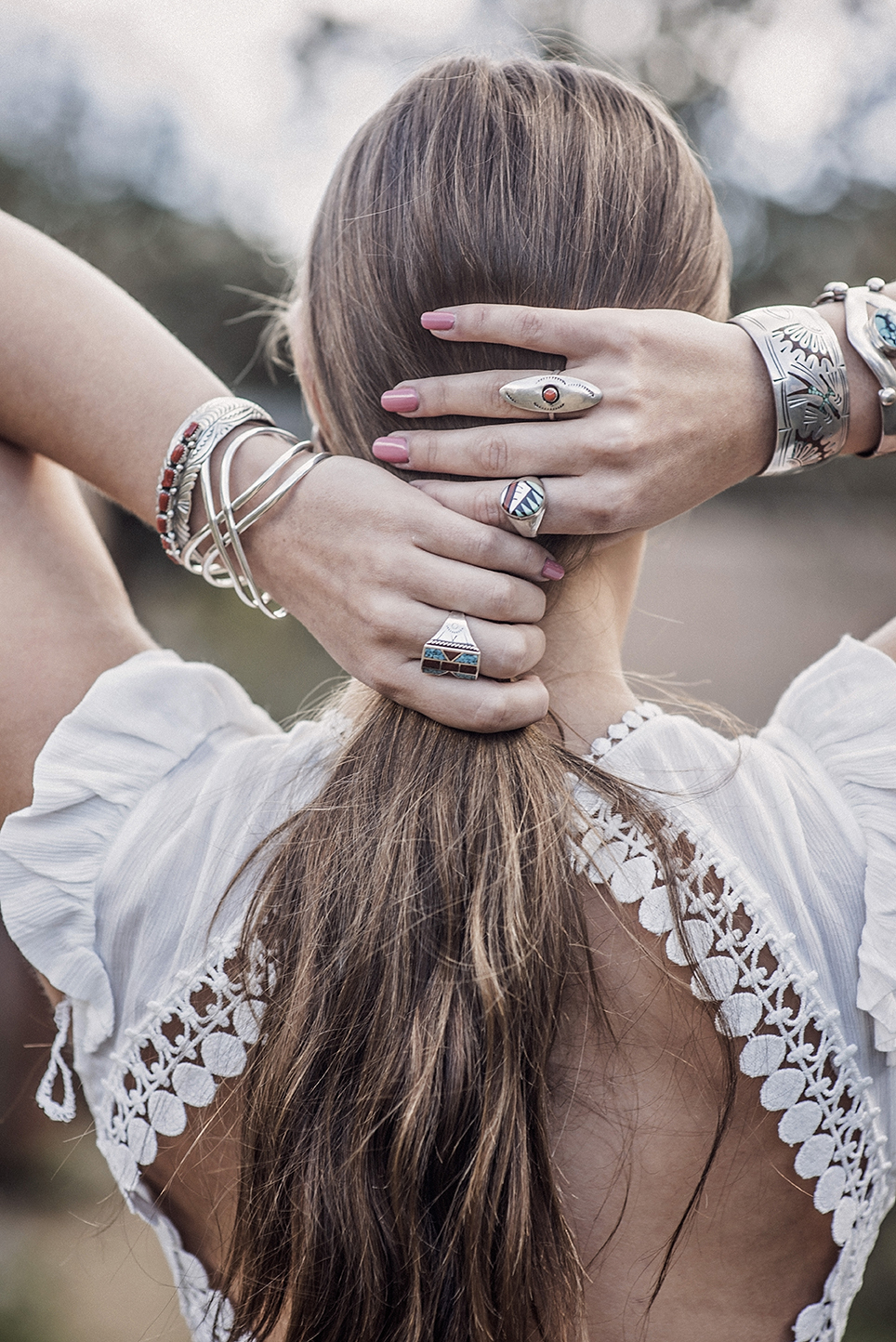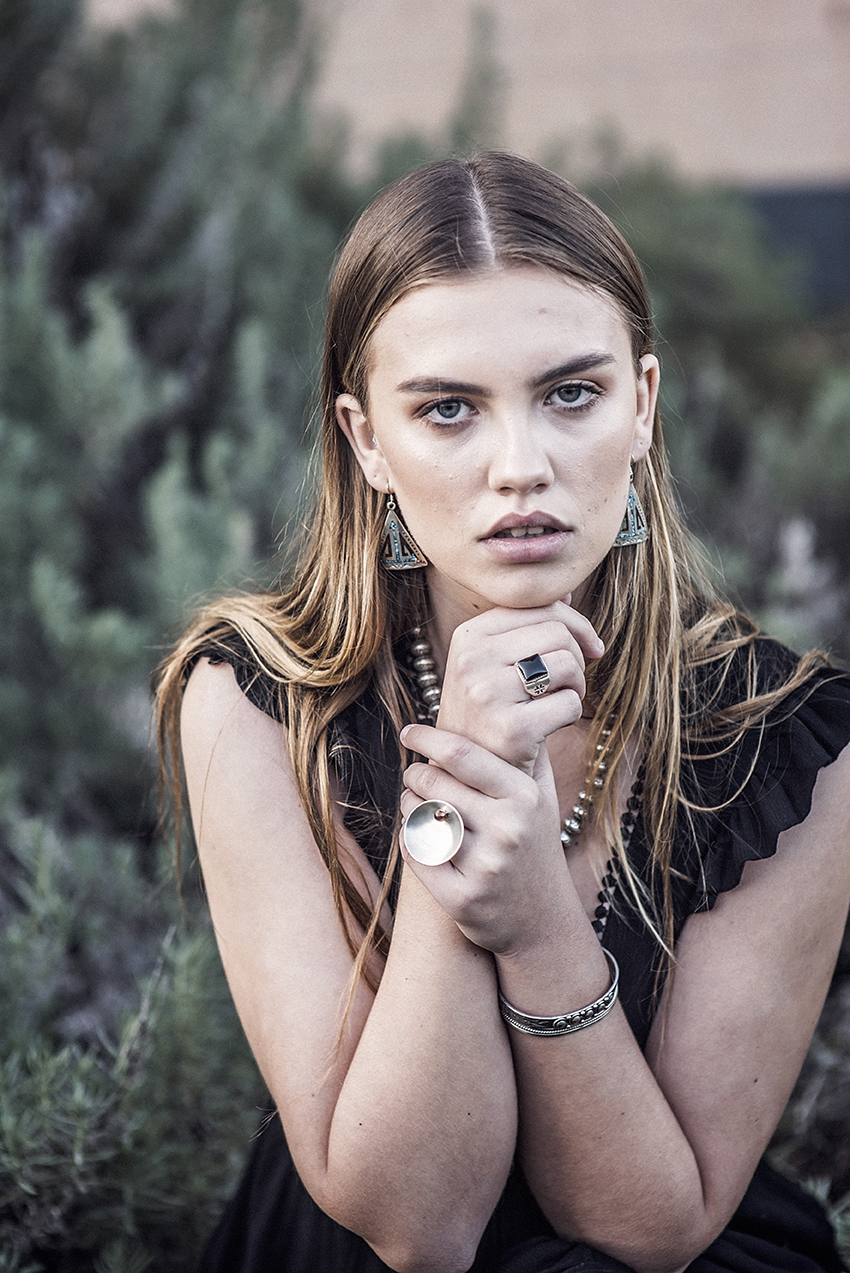How can I work out my ring size?
If you don’t already know your ring size, either pop into a jeweller and have them measure your finger with a ring size gauge, or take one of your existing rings and measure it against a ring size chart. Another option is to get a bit of string and measure your finger, put the string against a ruler to get the diameter of your finger and compare to this chart to get your size!
There are some great tips and a fantastic downloadable (and printable) ring size chart here.
Is your Native American jewellery genuine?
Yes. We sell only authentic Native American-made jewellery. We source it ourselves, wherever possible from the maker, and stand behind what we sell. We will advise the provenance of a vintage piece where it is known, and where it is not, we will provide you with our informed opinion.
Designs have changed since 1860 and the influence of non-Native Americans has increased over that time, but the creative vision and craftsmanship of Native American artisans remain predominant and the traditions are respected and upheld.
What is the difference between jewellery from different Native American tribes?
The Navajo
Navajo designs in the 19th Century were simple, consisting of silver pieces with simple decorations punched into the surface; for example, buttons. These later were incorporated into concha or concho belts. They also began to include turquoise into the silver jewellery, for example in squash blossom necklaces. By the early decades of the 20th Century the silver necklaces, brooches and bracelets commonly included turquoise into the designs. It is this use of turquoise in silver jewellery which is a particular characteristic of Navajo design.
The Zuni
Distinctive in Zuni designs is channel inlay, where inlays of turquoise, red coral and mother-of-pearl are combined with inlays of silver to form an intricate pattern. Another design that is shared with the Navajo, is the use in bracelets and brooches of clusters of small stones (turquoise and red coral in particular) arrayed in circles or grouped around a larger stone. Whereas the Navajo tend to employ small round stones, the Zuni more often use the petit-point style for these settings.
The Hopi
The overlay style is the one that is most associated with Hopi. The design is cut out in one piece of silver and another plain piece of silver is soldered onto the back, with sections blackened to make the design stand out. Surfaces are highly polished. The shapes employed are traditional symbols or objects such as animal paws, rain clouds, corn stalks and Kachina (including Kokopelli) dancing figures.
What is the fit for cuff bracelets?
The length measurements for our cuff bracelets include tip to tip inside (curved) length and gap in millimetres. The gap is the space you have to fit the bracelet over your wrist. We have indicated where the gap is flexible to any degree and where it is not flexible at all. For inflexible bracelets, you can work out whether it will go on your wrist by measuring the thickness of the fleshy part of your wrist behind the wrist bone (about 2.5 centimetres up your arm from your hand). To check fit, measure your wrist/arm circumference with a tape measure and compare it with the inside measurement of the cuff. If you have any questions, you can always contact us!
Is it real turquoise?
Turquoise has been popular as jewellery for thousands of years. But modern chemical processes have meant that artificial forms dominate the market – so let the buyer beware!
When you buy a piece of turquoise jewellery, how do you know it’s real? Some material sold as turquoise is actually plastic, so how do you protect yourself against the fakes? The simplest way is to look at the price: if it’s dirt cheap, it can’t be real. There is an old saying: ‘If it sounds too good to be true, it is’. The current market price of turquoise is about USD10-40 per carat.
Most turquoise sold in modern jewellery is not what it seems. Natural turquoise comprises only 10-15% of all turquoise sold. Much “turquoise” sold is actually dyed howlite. What should one look for? The most valuable turquoise is dense, with deep blue and green colour and seated in a complex matrix. It should also be cold to the touch and feel heavy.
Density refers to depth of colour. The finest stones have deep shades of blues or greens. The richness of the colour is important, whether blue or green; the fakes soon fade.
Matrix refers to the criss-cross pattern of lines caused by impurities in the stone. A stone is more valuable with even lines rather than an uneven, blotchy appearance. Spider-web matrices are the rarest and most-prized. Collectors in Asia and the Middle East prefer rock with no lines at all – which is called the “Robin’s egg” appearance.
The truth is that most of the turquoise sold today has been treated in some way to make it more saleable. Since the 1960’s these processes have become common and some have become accepted. Treatments include dyeing or waxing to deepen its colour; stabilising the material with acrylic and plastic bonding agents in order to harden it and permanently increase and protect its colour; or creating a new stone by adding an epoxy to pulverised fragments of turquoise to form hard cakes of base stone, which can then be formed and polished.
There are also temperature treatments, used in order to enhance the appearance of the turquoise long enough to make the sale. The treatments may use any of the following: oil, paraffin, aluminium oxide, silicon carbide, or various abrasives and polishes. Their effects may last from a few days to a few months, after which the stone bleaches out.
Here at Sky Stone Silver we only sell genuine turquoise.
What is "lab" opal?
“Lab” opal is shorthand for laboratory-created, or synthetic, opal. It has the same physical and chemical properties as natural opal, but has been made in a laboratory.
Why does my purchase look different from the photo?
Everything we sell at Sky Stone Silver is 100% handmade. As a result, each piece is unique and may look slightly different from the product photograph on the website.
How can I best care for my jewellery?
Caring for sterling silver jewellery is essential to ensure it stays looking good and maintains its value. Since many Native American jewellery pieces contain gemstones, great care must be taken to ensure the silver is cleaned without damaging the stones. We do not clean or polish any of our vintage pieces, instead leaving the original patina.
CARE OF STERLING SILVER JEWELLERY
Generally speaking, silver cleaning solutions, cleaners or creams should not be used to clean Native American silver jewellery. These types of solutions could damage the stones or inlay or cause the colour of the stones to change. Some Native American silver jewellery is made with a technique where areas of the jewellery are intentionally blackened to provide design definition (oxidisation); solutions would remove/damage the oxidised areas.
Therefore, we believe the best and simplest way to care for Native American sterling silver jewellery is to use silver polishing cloths that have been specially designed and treated for the purpose of cleaning sterling silver jewellery. These cloths are made of a felt-like material and are impregnated with special non-scratch micro-abrasives. You just rub the surface to be polished with medium pressure to remove tarnish and light surface scratches. We recommend the Sunshine Polishing Cloth.
Hopi Silver Overlay jewellery, in particular, should not be dipped in any type of liquid silver polishing cleaner, nor should you use any other type of chemical silver polishing cleaner or solution because the dark recessed oxidised areas will be ruined – the contrast of the design and hence the essence of Hopi jewellery will be lost. Use only silver polishing cloths like the ones we sell and avoid rubbing the dark recessed oxidised areas.
Keeping your sterling silver in the open air for extended periods of time without wearing it can cause it to tarnish. Believe it or not, wearing your silver jewellery is the best method for the prevention of tarnish! Infrequently worn silver jewellery should be kept in a sealed plastic bag. An important exception to this rule relates to the type of jewellery mentioned previously that has been intentionally oxidised or antiqued as part of the design. This type of jewellery should not be stored in airtight plastic bags, so simply punch a hole in the plastic bag.
Keep them dry
You’ve bought a lovely new piece of jewellery and you want to make sure it stays that way… if your piece has gemstones then it is best to keep it out of the water – take it off when you bathe or swim or wash your hands.
Vintage pieces need extra care and attention, especially if they have any inlay. Over time, the glue that keeps the inlaid shell or stones in place becomes brittle and your inlay may fall out if it is exposed to water. So keep your vintage piece out of the water – take it off when you bathe or swim or wash your hands. If you notice any gemstones loose in their bezels, you may want to have a jeweller take a look at it, to tighten the bezel for you so that the stones do not fall out.
CARE OF TURQUOISE JEWELLERY
Natural turquoise is a beautiful stone that is porous, so use caution when caring for and cleaning turquoise jewellery. Protect turquoise from extreme temperatures, cosmetics, perfumes, skin oils, grease, or any other harsh chemicals, as they might discolour the stone. When cleaning turquoise jewellery, use a very soft brush or a slightly damp soft cloth. Do not submerge turquoise in water and avoid using commercial jewellery cleaners, ultrasonic cleaners, chemicals or even soap. A polishing cloth is a safe way to clean or polish turquoise.
Remove jewellery before performing gardening, household tasks or any strenuous activity. Dirt can get into stone settings and may scratch the surfaces.
CARE OF INLAY JEWELLERY
Avoid dropping, banging or scratching inlay jewellery. Do not wash with soap and water. Instead, use polishing cloths to shine or clean inlay jewellery.
Do not attempt to reshape or bend a bracelet, necklace, ring or pendant with inlay or channel work. Do not resize rings with channel or inlay work. Changing the shape of the underlying metal can loosen the stones. They can actually pop out while the item is being bent and/or the integrity of the setting can be compromised, so that the stones may fall out later on, without being noticed.
Can I pay with a credit card?
Yes, you can pay with credit card via Woocommerce Stripe or using Paypal (Visa or Mastercard only). For more information on payments, click here.
How else can I pay?
We also accept payment via Afterpay (you can choose this option at checkout) or through direct bank transfer to our Australian bank account. Payment must be received within 5 working days of placing your order (unless you contact us to make other arrangements), or your order will be cancelled.
We also have a Transferwise account for customers wishing to pay in US dollars. For customers wishing to pay through Transferwise please contact us for our account details. Just choose “bank transfer” on checkout and once payment has been received we will ship your order.
What is Afterpay?
With Afterpay you can pay for your purchase over four instalments, due every two weeks. There are no fees if you pay on time – it’s basically like a modern version of lay-by or lay-away. For more information please see the Afterpay website.
PayPal is not working, what can I do?
We are aware of some issues with the PayPal website – either technical issues with the site loading or customers being unable to log into their PayPal account. If the page won’t load, we suggest you try again a bit later or instead use Woocommerce Stripe for credit card payments.
If you are unable to log into your account or do not have a PayPal account, but wish to pay by credit card via PayPal, please scroll down the page and select “Pay with card”. You should then be able to pay by credit card without logging into PayPal.
If you prefer not to pay by credit card, we also accept direct debit payments, you can just choose that as an option during checkout.
GLOSSARY OF TERMS
Appliqué is the practice of forming a shape of feathers, leaves or flowers and then soldering this onto another piece of jewellery as decoration. It is particularly a Navajo practice.
Channel inlay is a style where soldered silver compartments are added to the mosaic inlay design, which strengthens the individual compartments of inlay stones as well as the overall appearance of the design.
Chip inlay is a method where cavities in jewelry are filled with a mixture of crushed stone, typically turquoise and coral, and epoxy resin. The piece is then polished smooth after the resin has hardened.
Cluster work describes arrangements of well-matched stones or shell into flower patterns.
Coin silver is a standardized alloy of silver that has been used in the United States since 1792. Prior to 1906 there was no law defining coin silver, but it was an unofficial category used by manufacturers of silver products to assure their consumers. Often it meant that the silver in the products came from melted-down coins. From 1905 coin silver was standardised to an alloy of 90% silver and 10% copper.
Dead pawn refers to jewellery pawned but not claimed by the owner by the time of expiry of the period of the pawn. The system of pawning and recovering pawned items is still actively used by Native Americans in the southwestern United States. Buyers of dead pawn may have to sign a statement that they will return the piece if the original owner supplies the cash to redeem it.
Gemstones, precious – see Precious gemstones.
Gemstones, semi-precious – see Semi-precious gemstones.
Hallmark is a term to describe an official mark or series of marks set into items made of precious metals to designate the maker or company and the date of manufacture. It signifies the authenticity and genuineness of the item and mostly appeared after 1970.
Keum-boo (also Kum-Boo or Kum-bu – Korean “attached gold”) is an ancient Korean gilding technique used to apply thin sheets of gold to silver, to make silver-gilt. For more information, see Wikipedia and Ganoskin‘s website.
Liquid silver – the Santo Domingo people of New Mexico are recognised as the creators of heishi. Originally they used shell and turquoise, drilled with a small hand pump drill, rubbed smooth and strung. The ancient technique of heishi has been adapted to the use of sterling silver as well as shell and stone. When silver is used, drawing a ribbon of silver through a drawplate forms a thin, silver tube. These tubes are carefully cut into identical 32mm pieces and hand-strung together in various lengths. The term “liquid silver” is derived from the smooth and flowing watery effect created by the silver strands.
Milagro – the word milagro means “miracle” in Spanish. Milagros are miniature objects in silver, tin, or gold offered in thanks to a saint for granting a favour. A heart may be used to represent the worries of a heart condition or to represent the love someone might feel for another person. The use of such offerings was introduced to Mexico by the Spanish but they are now common elements of Mexican folk art.
Needlepoint design employs small elongated stones of similar colour in clusters and arrays of gemstones, where both ends of the stones are pointed.
Nickel or “German” silver is an alloy of copper with nickel and often zinc. It is named for its appearance, and normally contains no silver. The usual formulation is 60% copper, 20% nickel and 20% zinc. It is also called “alpaca”.
Old pawn is a term to describe authentic Native American jewellery made before 1940.
Overlay evolved from the appliqué technique where a cut-out design is soldered to a same-sized silver backing piece and etching or scratching or stamping is applied to the backing to increase the contrast between the top and bottom surfaces.
Petit-point is a refinement of cluster design, where the surface of small stones is rounded at one end and pointed at the other, to create a teardrop shape. It is often seen in cluster designs of necklaces and bracelets dating from the 1920’s, particularly in Zuni jewellery.
Precious gemstones in modern usage are diamond, ruby, sapphire and emerald, with all other gemstones being semi-precious.
Repoussé describes a textured effect in silverwork achieved by stamping the back of the silver to yield a raised pattern on the face. The effect may be contained within shapes such as crescents, or used as a border for the whole piece.
Semi-precious gemstones generally refer to gemstones other than diamond, ruby, sapphire and emerald. It should be noted that the terms “precious” and “semi-precious” are historical ones and do not reflect the value of a particular gemstone. Many semi-precious stones under this definition are more rare (and therefore more valuable) than some “precious” stones.
Shadow box refers to a gemstone that has been bezel-set inside a shallow oxidised or blackened silver frame.
Sterling silver is an alloy of silver containing 92.5% by weight of silver and 7.5% by weight of other metals, usually copper. The sterling silver standard has a minimum content of 925. The reason that silver is alloyed with copper is to give it strength, while at the same time preserving its ductility and beauty.


